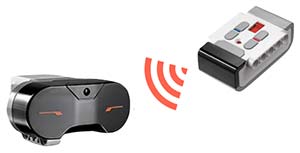遥控小车
使用EV3主机上的按键控制小车还是比较麻烦,能不能通过遥控来控制小车呢?
当然可以!
乐高提供了一个红外线传感器和遥控器:

但是红外遥控器需要很强的方向性,而且那个遥控器太简陋了,连个摇杆都没有。
还有一种方式是使用蓝牙手柄,这样我们就可以找一个游戏手柄直接通过蓝牙控制小车,太方便了有木有!
我找了一个任天堂的游戏手柄:

理论上支持蓝牙的游戏手柄都是可用的,标准游戏手柄按键如下:
┌──────┐ ┌──────┐
┌┴─────┐│ ┌┴─────┐│
┌─┴──────┴┴──────────────────┴──────┴┴─┐
│ ┌─┐ ┌─┐ ┌─┐ │
│ ┌─┐ └─┘ └─┘ ┌─┐│X│ │
│ ┌─┘ └─┐ - + │Y│└─┘┌─┐ │
│ └─┐ ┌─┘ ┌─┐ ┌─┐ └─┘┌─┐│A│ │
│ └─┘ └─┘ └─┘ │B│└─┘ │
│ ┌─┐ S H ┌─┐ └─┘ │
│ ┌─┘ └─┐ ┌─┘ └─┐ │
│ └─┐ ┌─┘ └─┐ ┌─┘ │
│ └─┘ └─┘ │
│ ──────────────────────── │
│ / \ │
│ / \ │
└────/ \────┘
把游戏手柄和EV3主机用蓝牙连起来很简单,但是怎么用Python程序读取手柄的输入?
一般来说,从外部设备读取输入时,应用程序并不直接与外设打交道,而是由操作系统通过驱动程序连接外设,然后,通过操作系统提供的API读取输入。Windows程序可以通过DirectX访问外设,运行在网页的JavaScript程序可以通过浏览器提供的Gamepad API。
EV3主机运行的是Debian Linux,那么Python程序如何在Linux下读取手柄的输入?
在Linux中,系统把每个外设都映射为文件,每个设备的输入也被映射为文件。/proc目录挂载的就是Linux的虚拟文件系统,映射Linux的进程信息和设备信息。我们登录到EV3,查看/proc/bus/input/devices文件:
$ cat /proc/bus/input/devices
I: Bus=0000 Vendor=0000 Product=0000 Version=0000
N: Name="LEGO MINDSTORMS EV3 Speaker"
P: Phys=
S: Sysfs=/devices/platform/sound/input/input0
U: Uniq=
H: Handlers=kbd event0
B: PROP=0
B: EV=40001
B: SND=6
I: Bus=0019 Vendor=0001 Product=0001 Version=0100
N: Name="EV3 Brick Buttons"
P: Phys=gpio-keys/input0
S: Sysfs=/devices/platform/gpio_keys/input/input1
U: Uniq=
H: Handlers=kbd event1
B: PROP=0
B: EV=3
B: KEY=1680 0 0 10004000
这个文件列出了目前系统可用的输入设备,上述两段分别代表扬声器和按钮设备。如果我们把蓝牙手柄连接到EV3,再查看文件,发现多了一段内容:
I: Bus=0005 Vendor=057e Product=2009 Version=0001
N: Name="Pro Controller"
P: Phys=00:17:ec:13:d8:1d
S: Sysfs=/devices/platform/soc@1c00000/serial8250.2/tty/ttyS2/hci0/hci0:2/0005:057E:2009.0003/input/input4
U: Uniq=00:90:e3:9b:ec:e9
H: Handlers=event2
B: PROP=0
B: EV=10001b
B: KEY=ffff0000 0 0 0 0 0 0 0 0 0
B: ABS=3001b
B: MSC=10
我们通过N: Name="xxx"来搜索手柄设备,然后,通过H: Handlers=xxx获取设备的输入文件。例如,上述蓝牙手柄的名称是Pro Controller,输入是event2,对应到系统文件就是/dev/input/event2。Python代码实现如下:
定义InputDevice类表示输入设备:
class InputDevice():
def __init__(self):
self.name = ''
self.handler = ''
def __str__(self):
return '<Input Device: name=%s, handler=%s>' % (self.name, self.handler)
def setName(self, name):
if len(name) >= 2 and name.startswith('"') and name.endswith('"'):
name = name[1:len(name)-1]
self.name = name
def setHandler(self, handlers):
for handler in handlers.split(' '):
if handler.startswith('event'):
self.handler = handler
定义函数listDevices()通过读取/proc/bus/input/devices文件获取所有设备:
def listDevices():
devices = []
with open('/proc/bus/input/devices', 'r') as f:
device = None
while True:
s = f.readline()
if s == '':
break
s = s.strip()
if s == '':
devices.append(device)
device = None
else:
if device is None:
device = InputDevice()
if s.startswith('N: Name='):
device.setName(s[8:])
elif s.startswith('H: Handlers='):
device.setHandler(s[12:])
return devices
定义函数detectJoystick()通过名字模糊查找手柄设备:
def detectJoystick(joystickNames):
for device in listDevices():
for joystickName in joystickNames:
if joystickName in device.name:
# 返回输入文件:
return '/dev/input/%s' % device.handler
# 未找到返回None:
return None
搜索到手柄设备后打开文件读取输入:
eventFile = detectJoystick(['Controller'])
if eventFile:
with open(eventFile, 'rb') as infile:
while True:
# 读取输入
现在最关键的问题来了:eventX文件应该以何种格式读取?
让我们搜索一下Linux文档,在input.txt中详细说明了eventX文件的输入格式。Linux系统把每一个输入事件都封装为一个C结构体让我们直接读取:
struct input_event {
struct timeval time; // 16字节时间戳
unsigned short type; // 2字节事件类型
unsigned short code; // 2字节事件代码
unsigned int value; // 4字节事件值
};
每次读取24字节并按照C的struct类型解码,即可得到手柄输入的全部信息。在Python程序中,可以用struct读取:
FORMAT = 'llHHI'
EVENT_SIZE = struct.calcsize(FORMAT)
with open(eventFile, 'rb') as infile:
while True:
event = infile.read(EVENT_SIZE)
_, _, t, c, v = struct.unpack(FORMAT, event)
print('t = %s, c = %s, v = %s' % (t, c, v))
注意到unpack()方法的返回值,我们丢弃了前两个8字节整数,保留了t、c、v,分别是2字节无符号整数、2字节无符号整数和4字节无符号整数。
根据Linux文档,再打印出每个事件的详细数据,把手柄的按键和摇杆都按一遍,就可以得到按键编码如下:
t==1时表示按键,此时v==1表示按下,v==0表示释放,v==2表示持续按下,对应的c表示按键编码。要检测A、B按钮按下,可以这么写:
if t == 1 and v == 1:
if c == 305:
# Button A pressed
pass
if c == 304:
# Button B pressed
pass
摇杆数据则比较复杂,类型t==3表示摇杆,如果c==0,表示左摇杆的左右移动,如果c==1,表示左摇杆的上下移动,v的值介于0~65535,32768表示中心值,越往两侧偏移越多则越接近最大和最小值:
0
▲
│
0 <───┼───> 65535
│
▼
65535
现在我们就可以通过一个读取手柄的无限循环来控制小车:
def joystickLoop(robot, eventFile):
FORMAT = 'llHHI'
EVENT_SIZE = struct.calcsize(FORMAT)
with open(eventFile, 'rb') as infile:
while True:
event = infile.read(EVENT_SIZE)
_, _, t, c, v = struct.unpack(FORMAT, event)
if t == 1 and v == 1:
if c == 305:
# A键加速:
robot.setSpeed(1)
elif c == 304:
# B键减速:
robot.setSpeed(-1)
elif c == 307:
# X键退出:
return robot.inactive()
elif t == 3:
if c == 1:
# 左摇杆上下移动:
speed = 0
if v < 32768:
# 加速:
speed = 1
elif v > 32768:
# 减速:
speed = -1
robot.setSpeed(speed)
但是另一个问题来了:主线程通过死循环读取手柄输入,那么怎么读取超声波传感器的数据?
可以利用Python的threading启动多线程,在另一个线程中不断检测超声波传感器,并在条件达到的时候自动停车:
def autoStopLoop(robot):
while robot.active:
if robot.speed > 0 and robot.ultrasonic.distance() < 200:
robot.setSpeed(0)
wait(100)
joystickEvent = detectJoystick(['Controller'])
robot = Robot()
t = threading.Thread(target=autoStopLoop, args=(robot,))
t.start()
joystickLoop(robot, joystickEvent)
到此为止,一个蓝牙手柄控制的机器人程序就宣告完成。试试效果:

